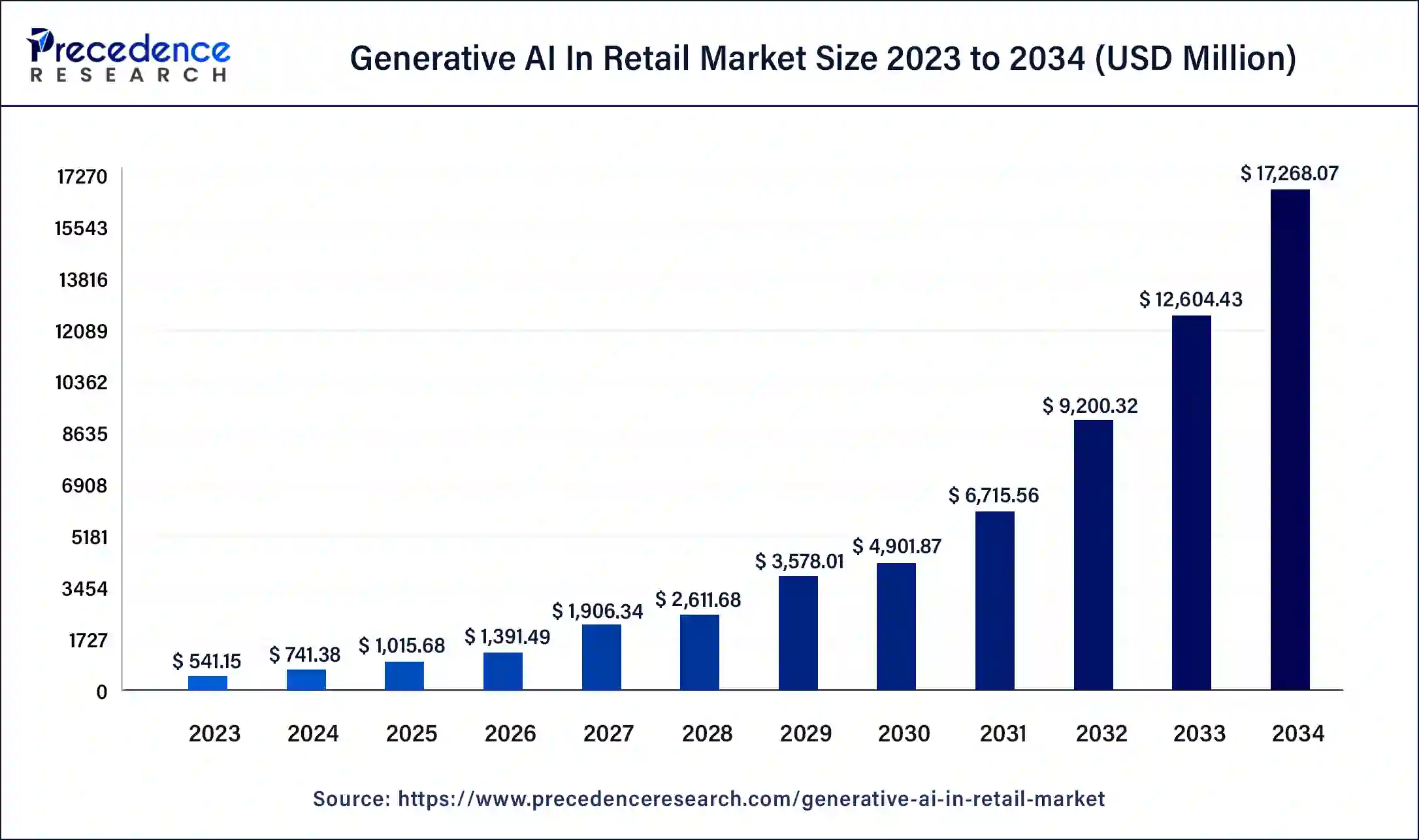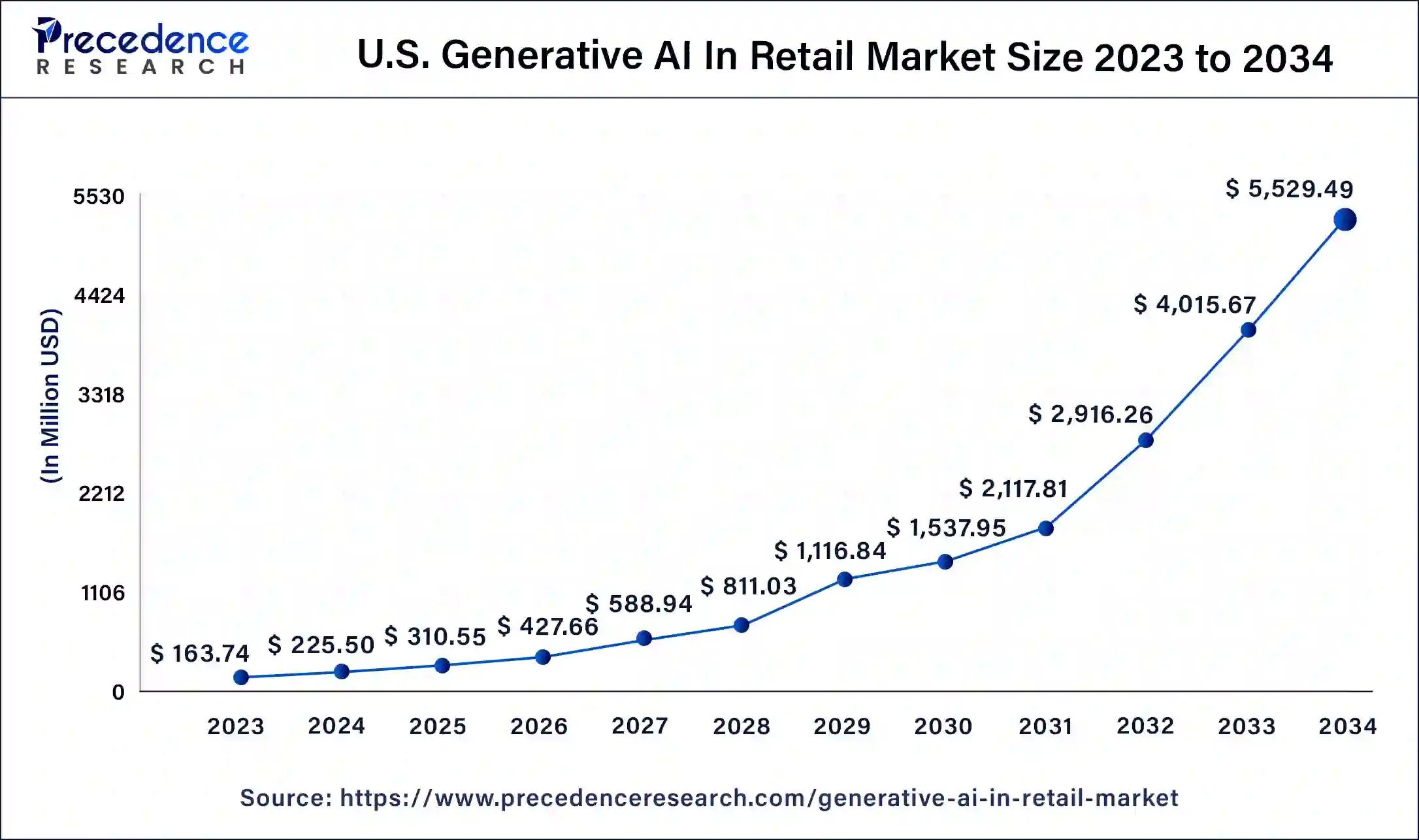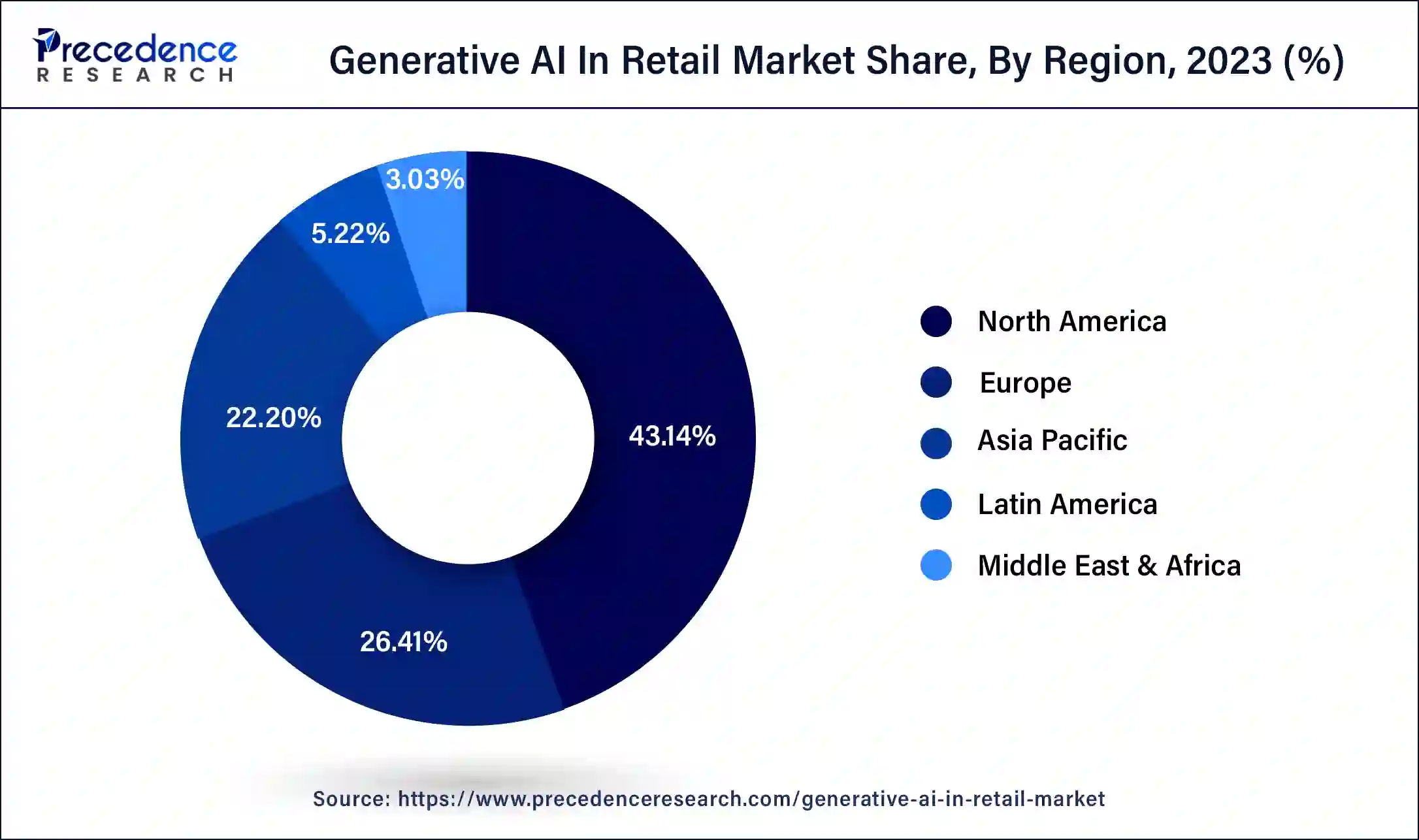January 2025
Generative AI in Retail Market (By Application: Supply Chain and Logistics, Sales and Marketing; By End-User: Physical Stores, Online Stores, Supermarkets and Hypermarkets) - Global Industry Analysis, Size, Share, Growth, Trends, Regional Outlook, and Forecast 2024-2034
The global generative AI in retail market size was USD 541.15 million in 2023, calculated at USD 741.38 million in 2024, and is expected to reach around USD 17,268.07 million by 2034. The market is expanding at a solid CAGR of 37% over the forecast period 2024 to 2034.

The U.S. generative AI in retail market size was estimated at USD 163.74 million in 2023 and is predicted to be worth around USD 5,529.49 million by 2034, at a CAGR of 37.7% from 2024 to 2034.

North America dominated the market with the largest market size in 2023. The growth of the region is increased due to the rapid rate of technological advancements in this region. Economically developed nations like the United States and Canada will likely propel the use of generative AI technology in the retail industry. Increasing investments by the major market players in artificial intelligence in the region will result in the growth of artificial intelligence in retail market. Increasing adoption of artificial intelligence by several industries like retail services, automobiles, etc. anticipated the rise of the market across the region.
The presence of large consumer base to shop online has forced the e-commerce industry to adopt advanced techniques to boost consumer satisfaction. This element promoted the adoption of generative AI in the retail industry in North America. To improve consumer satisfaction, generative AI offers virtual try-on systems for customers along with predictive images of products for better understanding.
North America holds the largest market share at 43% of the total global share of artificial intelligence. The shares can be attributed to major technology company players like Microsoft, Google, and IBM.

Asia Pacific is expected to the expected to grow at the fastest rate during the forecast period. The market’s growth in Asia Pacific is driven due to rising population rate and technological advancements in this region. The region is experiencing an enormous rise in e-commerce shopping, the interest in e-commerce websites is observed to fuel the market’s growth in the region. Generative AI captures the need and requirements of consumers by analyzing their behavior through algorithms.
Moreover, the willingness of retail businesses to adopt advanced technological solutions to address the business challenges acts as a growth factor for the market in Asia Pacific. Asia Pacific emerging with the fastest rate in artificial intelligence globally with 42% of the global shares. The rapid growth of the Asia Pacific AI growth is attributed due to the presence of tech giants in the region.
Market Overview
Artificial intelligence is the most advanced and emerging trend recently. The working technology and speed is the major attraction of these technologies. In recent times where almost every person depends on technology for their business to domestic work, it is the most effective and smarter way to do it. Generative artificial intelligence is the major attraction for investors' investment for generating profit. Generative AI is filled with many application which is useful for its consumers.
Generative AI is in the retail industry is capable of offering services to maintain and improve the interest according to the choices by analyzing their searches on social media or any other platform. Generative AI algorithms fetch the consumer behaviors and visualized the data or preferences to the consumers according to the requirement of the consumers. Generative artificial intelligence also can be helpful in the retail industry as it provides information about the logistics and supply chain which can rescue the excess expenditure by the retailer.
Generative AI is having its hands-on the several industries like automotive, retail, communication, healthcare, etc., retail industry is one of the fastest growing industries due to the rising disposable income of consumers across the globe and rising personal requirements resulting in the higher demand in multiple products. Recently, generative AI has started playing a very significant role in the retail industry by providing valuable information about the consumer to the retailer.
| Report Coverage | Details |
| Market Size by 2034 | USD 17,268.07 Million |
| Market Size in 2023 | USD 541.15 Million |
| Market Size in 2024 | USD 741.38 Million |
| Market Growth Rate from 2024 to 2034 | CAGR of 13.82% |
| Largest Market | North America |
| Fastest Growing Market | Asia Pacific |
| Base Year | 2023 |
| Forecast Period | 2024 to 2034 |
| Segments Covered | By Application and By End-User |
| Regions Covered | North America, Europe, Asia-Pacific, Latin America, and Middle East & Africa |
Rising focus on improving the shopping experience for customers
Generative AI models offer digital shelving for clothing and other fashion items, this application is considered to boost the consumer satisfaction that prefers online shopping. Generative AI models also offer virtual trials, predictive styles and even generate product reviews for online shopping. Customers may use this sort of AI clothing application to swiftly choose the best and most suited outfit. In the retail industry, generative AI therefore improves the shopping experience and helps customers select the appropriate goods a wide range of products. Such services for improving customer’s shopping experience are being adopted by physical/offline stores too, robotics and communication touchscreen panels are being deployed with the abilities of generative AI in such stores. Customers may get essential information about product locations and other advantages of employing AI virtual assistants inside businesses from AI in-store robots. Retailers' personnel costs might be decreased as a result of AI helpers. This retail AI solution enhances services, reduces costs, and draws in new clients, such efforts for improving consumer experience are expected to drive the growth of the market.
The complex procedure of installation
Despite the numerous advantages of generative AI in the retail industry, the cost factor associated with the adoption of such models creates a significant restraint for the market’s growth. Retailers have to transform the existing traditional system of operation while adopting advanced generative AI models in the business. The inference of generative AI models is more complex than the non-generative models. Along with this, the complicated procedure of understanding the operating system creates a challenge for retailers. The installation as well as the management cost hinders small-scale retailers from adopting the generative AI models, which acts as a restraint for the market’s growth.
Growing adoption of robotics for automation in the retail industry
Multiple industries across the globe are witnessing a shift with the adoption of robots that carry artificial intelligence systems. AI robots when associated with generative AI solutions, can help the retail industry in back-office operations, in-store operations, and even in sales and marketing.
The penetration of generative AI models in robots enables the advancements in learning approach for the robots, it also offers supervised training for robots without any human intervention. The rising adoption of robotic automation and even coordinated robots in the retail industry will open a plethora of opportunities for the market to grow in the upcoming period.
The supply chain and logistics segment held the largest share of the market in 2023, the segment will continue to grow at a significant rate during the forecast period. The growth of the segment is attributed to the rising use of generative AI in the supply chain and logistics segment to analyze the requirement of inventory. Generative AI is useful in the supply chain to minimize the challenges that come with the expansion of the market. Generative AI helps to fulfill customer expectations, manage market fluctuation, and the increasing requirement for sustainability in the market.
With the help of the algorithms of generative AI the supplier chain retailer or the stakeholder can analyze the volume of the products or data, and it helps in better decision-making for inventory management. The use of generative AI in supply chain and logistics is for reducing the excess cost of the retailer by the overstocking or shortage of stock of the products.
On the other hand, the sales and marketing segment is expected to hold a noticeable market share during the forecast period. Generative AI is observed as one of most powerful technologies for the sales and marketing segment for customer experience, productivity, and growth. Artificial intelligence helps in the growth of sales performance and effectiveness by automating sales activities and helps in reducing the cost of marketing. Hence generative AI is impacting the growth of sales and marketing segments in the industry. The generative AI algorithms also offer predictive analysis of industries, this element is observed to help retailers managing their marketing strategies.
In June 2023 Microsoft launched Viva Sales, a generative AI technology that is helpful for the salesperson and sales manager to draft customized emails to customers for getting information about customers and prospects and create reminders and recommendations. Salesforce followed the same application technology by launching “Einstein GPT.”
The online store segment dominated the market with the largest market share in 2023, the segment is expected to continue its growth during the forecast period. The growth of the segment is attributed to the rising use of social media and the increasing demand from the millennial generation that would likely get their required product online to their doorstep. Online stores gaining a major attraction among consumers due to the wide variety of products and easy availability and delivery of the product without stepping out from home.
Generative AI helps the online store by analyzing the need and choices of the consumers through their search algorithms on the internet.
Online shopping gives personal assistance to consumers on e-commerce websites for a better customer experience. Generative AI creates content that is associated with the product searched by the consumers. Thus generative AI has positively impacted the growth of the online store segment in recent years, this growth is expected to continue in the upcoming period.
Google is launching the latest technology in Generative AI for shopping. It will be aiming to get hands on the e-commerce sites like Amazon, Flipkart, etc. Google is also launching a new perspective to research the travel destination by using generative AI technology that can create text, videos, and images from prompts.
On the other hand, the physical stores segment is expected to witness a noticeable growth during the forecast period. The rising trend of automation in malls and stores promote the growth of the segment. Generative AI is observed to offer optimized operation solutions while helping the physical stores to adopt potential ideas for sales marketing. This element will boost the adoption of generative AI systems by physical stores.
Recent Developments
Segments Covered in the Report
By Application
By End-User
By Geography
For inquiries regarding discounts, bulk purchases, or customization requests, please contact us at sales@precedenceresearch.com
No cookie-cutter, only authentic analysis – take the 1st step to become a Precedence Research client
January 2025
July 2024
September 2024
January 2025